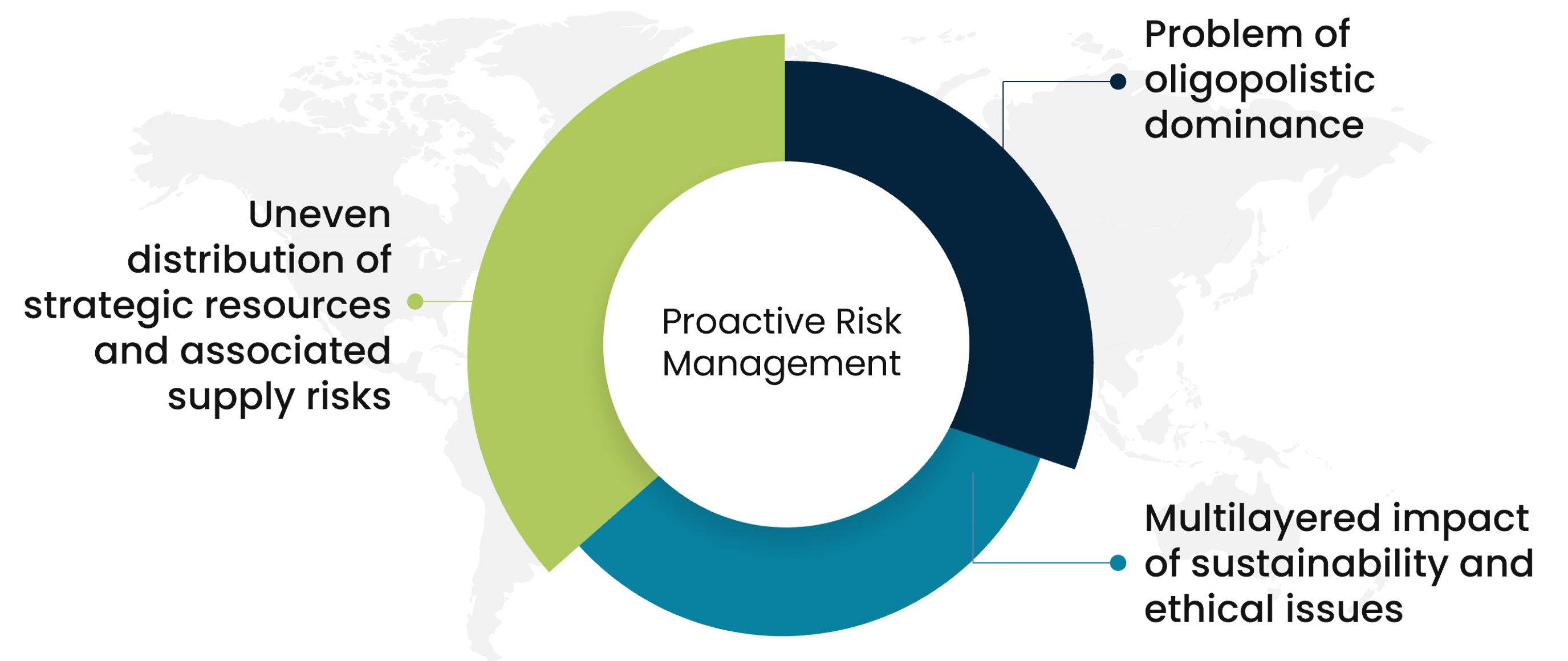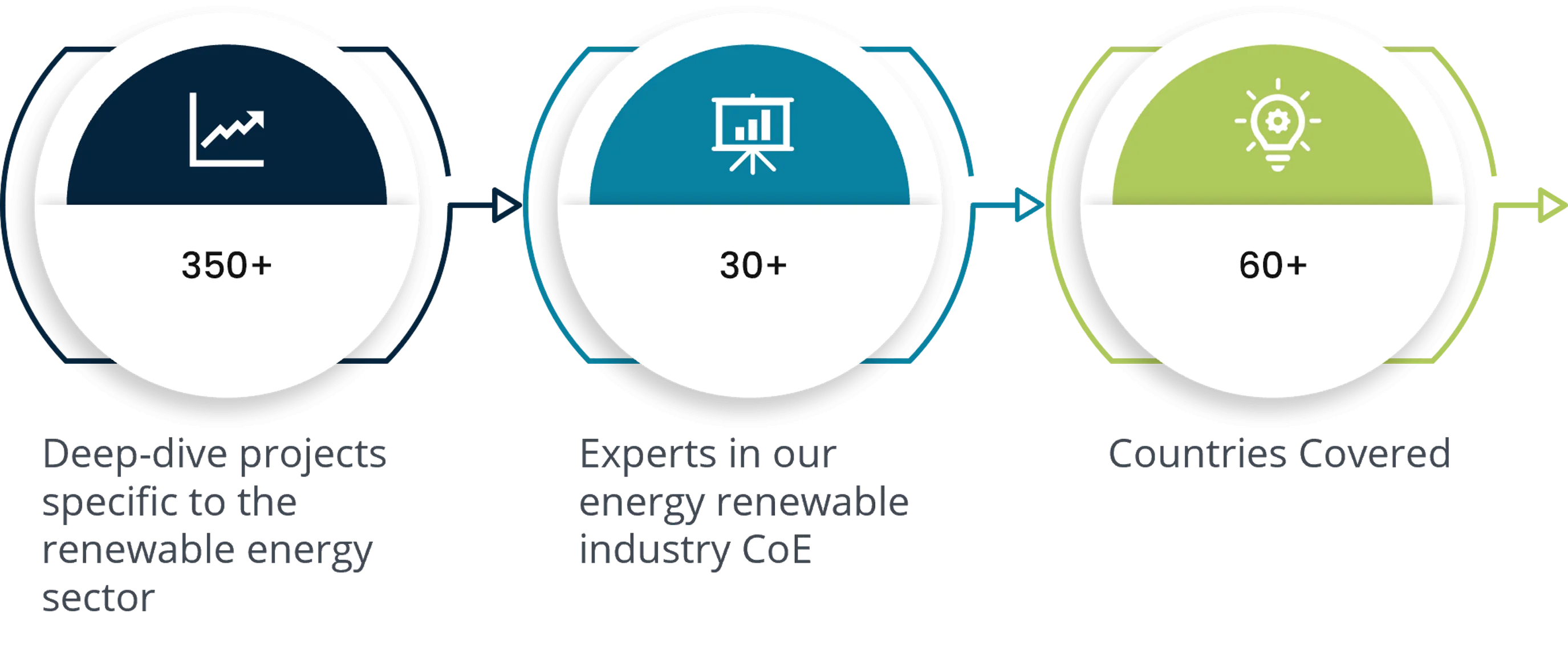By: Ankur Rishi
Key takeaways
- Renewable Energy Market Growth: Driven by incentives and increased demand, the renewable energy sector is flourishing, contributing significantly to the global electricity mix.
- Challenges in Renewable Energy Procurement: Despite the benefits, renewable energy procurement faces hurdles like supply-side issues, concentration of resources, and ethical considerations, necessitating careful navigation.
- Procurement Strategies for Renewable Energy: Businesses can leverage various approaches like Energy Attribute Certificates (EACs), Power Purchase Agreements (PPAs), and Virtual Power Purchase Agreements (VPPAs) to procure renewable energy effectively.
- Importance of Proactive Risk Management: Given the complexities of renewable energy procurement, proactive risk management is crucial to mitigate challenges related to resource distribution, market dominance, and sustainability issues.
Spurred by incentives and growing demand, the renewable energy sector (wind, solar, geothermal, hydropower, ocean energy, biomass) is booming. Nearly a third of the world’s electricity comes from renewables, led by hydropower (17%). Wind and solar represent 12% of global electricity generation. Despite the all-too-obvious upsides, renewable energy projects continue to be rattled by supply-side issues as much as their fossil-fuel counterparts. Uneven distribution of strategic input materials, a small number of manufacturers wielding significant influence, and the concentration of resources in fewer hands are preventing businesses from getting optimum mileage out of renewable energy procurement. Besides, businesses must dexterously negotiate the sustainability and ethical issues lining their supply channels while signing on, say, a renewable energy independent power producer procurement program.
Industry Overview
In the context of climate change mitigation and the increasing emphasis on sustainability, the renewable energy market has emerged as a pivotal player in shaping the future of electricity procurement for organizations worldwide. The drive towards clean power has gained momentum as businesses seek to reduce their carbon footprint and embrace clean energy supply options to mitigate environmental impact.
One of the key challenges faced by organizations in traditional electricity procurement is the price volatility associated with fossil fuels. This unpredictability in electricity prices can significantly impact operational costs and long-term financial planning. In contrast, renewable energy offers a more stable and predictable pricing structure, reducing the risks posed by electricity price volatility.
To capitalize on the benefits of renewable energy, many organizations are opting for longer-term contracts with renewable energy developers. These agreements, such as Virtual Power Purchase Agreements (VPPAs), enable businesses to secure a stable and cost-effective renewable energy supply while supporting the expansion of renewable capacity on the grid.
By partnering with renewable energy developers, organizations can access clean energy solutions tailored to their specific needs and sustainability goals. These partnerships not only contribute to reducing greenhouse gas emissions but also promote the development of a more resilient and sustainable energy infrastructure.
Three approaches: Renewable energy procurement
Energy Attribute Certificates (EACs)
EACs are certificates that confirm the generation and delivery of 1 MWh of clean energy to the grid. When a company purchases EACs, they become the owner of the sustainability claim linked to that energy generation. EACs are easy to procure and cost-effective.
A Power Purchase Agreement (PPA)
PPA is a long-term contract between a renewable energy developer and a buyer. It involves the purchase of clean energy (power and associated EACs) from a specific asset at a predetermined price. This enables buyers to claim the environmental benefits of these EACs. PPAs offer price stability and facilitate renewable energy procurement in tight markets.
A Virtual Power Purchase Agreement (VPPA)
VPPA is a contract between a renewable energy project developer and a buyer, usually a corporation. In a VPPA, the buyer commits to buying a specific amount of renewable energy from the project over a set time. Unlike a traditional PPA, where the buyer uses the power generated by the project, in a VPPA, the power is sold to the grid. The buyer benefits financially from the price difference between the contract and market electricity rates. The buyer also receives renewable energy certificates. Companies often choose VPPAs to benefit from price stability, cut their carbon emissions, and gain additional flexibility.
Business success through renewable energy trends
Companies can make social and environmental scores by increasingly embracing renewables and through corporate renewable energy procurement, but there are the financial “hard numbers” that should be equally compelling for CPOs. From a bottom-line perspective, renewable energy purchases will lower utility bills and meet business’s growing appetite for energy, while reducing their exposure to fluctuating fossil fuel prices. Besides there are lucrative incentives for investments in green technology (e.g., 100% tax exemption by Malaysia, 2013-2020) as well as various credits, VAT exemptions, interest-free loans, and more. Importantly, with subsidization of renewable energy, suppliers are providing products at lower costs.
Proactive risk management in the era of renewable energy

Uneven distribution of strategic resources and associated supply risks
Concentration of critical raw materials in certain countries is a key issue hobbling faster development and proliferation of renewable energy projects worldwide. For instance, nearly four-fifths of solar-grade silicon, the most important ingredient of photovoltaic cells, comes out of China. Large offshore wind turbines use high-performance permanent magnets composed of rare earth elements (REEs), and China is again the source of up to 60% of the world’s REEs. The remaining share of REEs was carved up between Australia, Burma, the US, and Thailand. In an age of political instability, geopolitical maelstroms, and trade wars, the risk of overconcentration, leading to supply disruptions and soaring prices, can’t be overstated. These are certainly roadblocks for corporate renewable energy procurement.
Problem of oligopolistic dominance
This links back to the previous idea about concentration of strategic resources in fewer hands. Renewable power’s growth has also stimulated demand for associated equipment. However, a few large sellers continue to exercise significant influence over the market, raising daunting barriers to entry for new entrants. Take the case of the large hydro turbine sector. Nearly eight major manufacturers across Austria, China, Germany, Japan, Russia, and the US hold more than three-quarters of that market. Seven of the top-ten polysilicon producers are from China, and one each from Germany, South Korea, and the US. Chinese manufacturers boast up to 80% share of solar panel manufacturing, all the way from polysilicon to solar modules. More than 95% of the solar PV inverter market is in the hands 15-16 firms from China, Germany, Israel Japan, and Spain. Nine Chinese businesses together account for more than 70% of this market. Such oligopolistic markets typically result in reduced competition, increased cartelization, higher prices, and fewer choices for customers. Of course, these are disincentives for any renewable energy independent power producer procurement program.
Multilayered impact of sustainability and ethical issues
Renewable energy is helping accelerate humankind’s transition away from fossil fuels and toward zero-emission electricity. That said, rollout of new renewable energy plants is reckoned to cause some degree of environmental impact. Ironically, clean energy projects, including solar energy procurement, could potentially intensify the mining of raw materials like silver and aluminum used in solar panels and mounting frames. Heavy metal contamination of water bodies in Guatemala is believed to be the consequence of silver mining. Australian miners, meanwhile, have expanded their extraction efforts, displacing indigenous people. Procurement organizations in the renewable energy sector risk huge fines and legal action, apart from reputational damage, where their supply chain participants are caught on the wrong side of various ESG (environmental, social, governance) mandates. Such violations include the use of forced labor, compromise of worker safety, and involvement in environmental degradation.
The role of renewable energy procurement in business growth strategies
Businesses are under growing stakeholder pressure to take stock of their greenhouse gas (GHG) emissions, lower such emissions with every passing year, and publicly report the progress of their “greening” efforts and impact on the planet. Buying renewable energy under, say, a renewable energy independent power producer procurement program, is a sure-shot way to meet regulatory mandates, generate jobs in clean energy, boost community well-being, and improve the perception that significant others have about the company.
What is the process for energy procurement?
Assess the need
Start by analyzing your energy requirements. Look at historical usage data and consider future needs. Take into account factors such as peak demand, seasonal variations, and any energy efficiency improvements that can reduce your energy demand.
Set the budget
Set aside money in your budget specifically for energy costs. This entails projecting energy expenses in light of the state of the market, anticipated consumption trends, and any contractual duties. Ensure that your budget and your financial objectives are in line.
Analyze the market
Keep an eye on the energy markets to comprehend the patterns in prices, both now and in the future. Keep up with the commodities markets, such as those for electricity and natural gas. Making educated selections can be aided by having knowledge about the market situation.
Choose the right suppliers
Select energy suppliers or vendors carefully. Evaluate potential suppliers based on various factors, including cost competitiveness, reliability, contract terms, and sustainability initiatives. Consider the reputation and track record of the suppliers.
Negotiate contracts
Work closely with chosen suppliers to negotiate the terms of your energy supply contracts. This involves determining the pricing structure (fixed, variable, or combination), the contract duration, and any special terms or clauses that protect your interests.
Consider renewable energy
If sustainability is a priority for your organization, explore options for procuring renewable energy. This could involve entering into power purchase agreements (PPAs) for wind or solar energy or purchasing green energy certificates to support clean energy initiatives.
Manage risks
Energy prices can fluctuate. Implement risk management strategies to mitigate these price risks. You may consider hedging strategies, flexible contract arrangements, or diversifying your energy sources to reduce exposure to price fluctuations.
Monitor and optimize
Continuously track your energy consumption to identify opportunities for energy conservation and efficiency improvements. Ensure accurate billing and timely payments. Regularly review your energy procurement strategy to assess its effectiveness and identify areas for improvement. This might involve renegotiating contracts to secure better terms, optimizing energy use, and exploring new technologies and initiatives that align with your goals.
Why Choose SpendEdge?

As previously discussed, renewable energy procurement promises a slew of compelling benefits for businesses across the three pillars of ESG. However, for these promises to fructify, buyers must stay clear of non-compliant, dishonest, fraudulent, and fiscally unstable suppliers. They might expose buyers to avoidable litigations and penalties, and, what’s worse, sully carefully sculpted brand reputations. Plus, there is the operational downtime to consider. Our experts in corporate renewable energy procurement with more than two decades of hands-on experience help renewable energy buyers partner with suppliers who are committed to complying with all regulatory mandates, covering renewable energy generation and sales. Our supplier assessment framework is designed to measure the performance of potential supplies against various criteria (e.g., occupational hazard prevention measures, forced labor/child labor risks). At the same time, our category managers check out suppliers based on their innovative capabilities such as the use of software tools to bolster productivity. The overarching aim is to help CPOs derive the most value from their renewable energy spend by developing a clear perspective of renewable energy regulations, standards, and incentives and establish straight-line connections between them and procurement overheads.
Success stories: How SpendEdge transformed renewable energy procurement with market intelligence and cost savings
Our client is an automotive ancillaries manufacturer seeking to make significant investments in wind and solar energy with a view to decarbonize business operations expeditiously, benefit from various tax incentives, and maximize ROI. The business was referred to us by one of our longstanding clients, and after the necessary due diligence, the client began to work with our experts in corporate renewable energy procurement almost instantly. The key outcomes the client expected from our procurement experts included developing a deeper understanding of the renewable energy landscape for specific countries and, further on, identifying clients for long-term engagement. Our study considered the regulatory landscapes of six major geographic regions as well as 15 representative countries in each region for renewable energy procurement. Countries were scored based on their certifications (RECS, GoO, I-RECs, no certification). Within each region, countries were positioned based on renewable energy price capping and regulatory stringency. Furthermore, we estimated the share of renewable versus non-renewable energy sources for each of the previously mentioned country markets. The level of intricacy and the breadth of issues involved in purchasing renewable energy were also examined at a country level to identify the most suited country in each region for renewable energy procurement. Significantly, our experts also worked out the average unit price of renewable energy for each country market. Our study is serving as a baseline for the client to engage with renewable energy providers for the longer term in major geographic markets.
Trustworthy procurement intelligence is the negotiation chip renewable energy buyers looking to derive the most value from deals need. With years of experience in corporate renewable energy procurement, our experts can help you get the upper hand in supplier negotiations. So, contact us now.
Conclusion
As the global community intensifies efforts towards climate change mitigation, the renewable energy market emerges as a cornerstone in reshaping electricity procurement strategies for organizations worldwide. Fueled by incentives and a growing demand for sustainability, the renewable energy sector, encompassing wind, solar, geothermal, hydropower, ocean energy, and biomass, is experiencing unprecedented growth. Despite the undeniable benefits of clean power, challenges such as price volatility in traditional electricity procurement persist, emphasizing the need for more stable and predictable clean energy supply options. Organizations are increasingly turning to longer-term contracts with renewable energy developers, including Virtual Power Purchase Agreements (VPPAs), to secure cost-effective renewable capacity while supporting grid expansion. By adopting renewable energy procurement strategies such as Energy Attribute Certificates (EACs), Power Purchase Agreements (PPAs), and VPPAs, businesses can not only reduce their carbon footprint but also mitigate risks associated with electricity price volatility. These approaches offer price stability, flexibility, and opportunities for sustainable growth while supporting the development of a resilient energy grid.
Author
Ankur Rishi
Vice President, Sourcing and Procurement Intelligence
With more than 12 years of advisory experience, Ankur manages platform content and services within the sourcing and procurement vertical. Over the years, Ankur has provided consulting services to category leaders from chemicals, energy, and packaging industry, on varied topics, such as category strategy, spend analysis, commodity pricing, and clean-sheet analysis.




